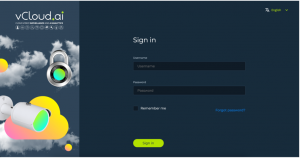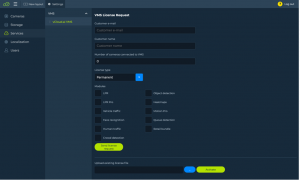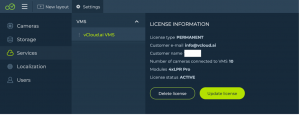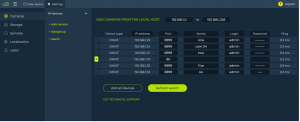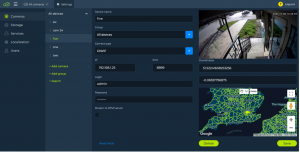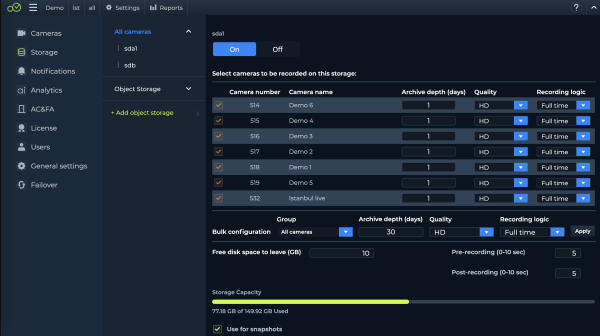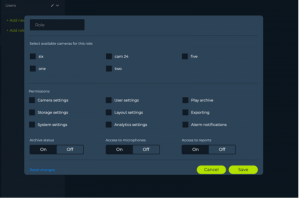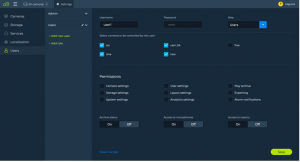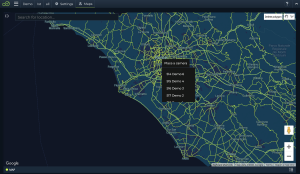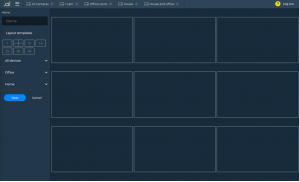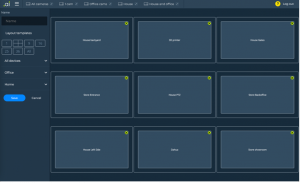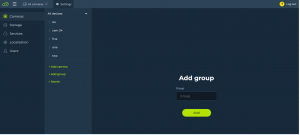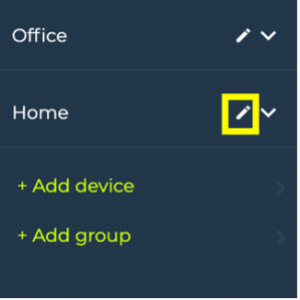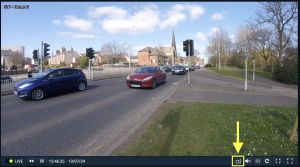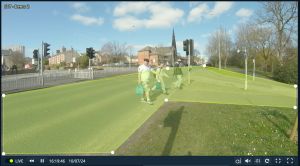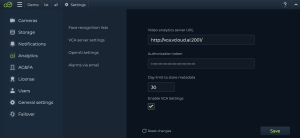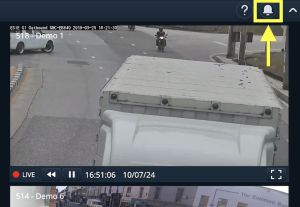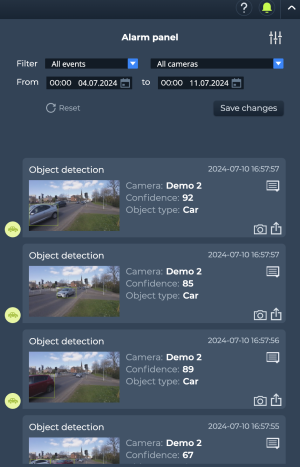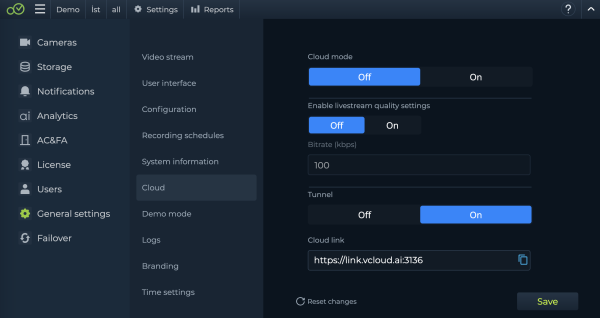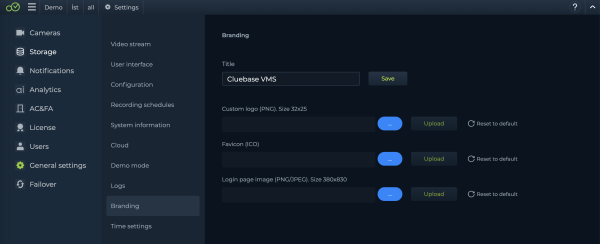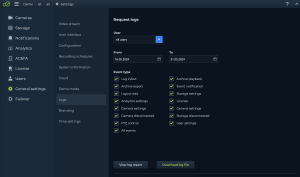Difference between revisions of "Cluebase VMS User Manual"
| (9 intermediate revisions by the same user not shown) | |||
| Line 18: | Line 18: | ||
== Compatibility<br> == | == Compatibility<br> == | ||
1. Codecs: Cluebase VMS is ready to work with any h.264 and h.265.<br>2. All IP cameras and DVR/NVR are compliant.<br> | |||
== Client app installation<br> == | == Client app installation<br> == | ||
| Line 85: | Line 84: | ||
[https://youtu.be/SVz-150uOLA Watch Creating a New Layout video in Cluebase VMS Tutorials on YouTube]<br> | [https://youtu.be/SVz-150uOLA Watch Creating a New Layout video in Cluebase VMS Tutorials on YouTube]<br> | ||
== | == Multi-server functionality == | ||
Cluebase VMS allows for creating multi-server systems in order to: | |||
[[File: | |||
# Manage all servers and cameras from a single client | |||
# Creating unified layouts containing cameras from multiple-server | |||
# Receiving alarms from multiple servers to a single client. | |||
Go to: Main menu -> Settings-> Cameras -> Bind server | |||
[[File:Bind.png|alt=bind|none|thumb|600x600px]] | |||
Fill the server access fields and click bind. | |||
== Storage settings == | |||
To access the storage settings go to: Main menu -> Settings-> Storage | |||
[[File:Storage.png|alt=storage|none|thumb|600x600px]] | |||
To enable a storage volume for recording please select the storage volume and switch it on:<br> | To enable a storage volume for recording please select the storage volume and switch it on:<br> | ||
[[File:Picture 11.png|thumb|none]] | [[File:Picture 11.png|thumb|none]] | ||
Then select the cameras that are required to be recorded, set archive depth, select quality and click Save. The storage will be activated for recording immediately. | Then select the cameras that are required to be recorded, set archive depth, select quality and click Save. The storage will be activated for recording immediately. | ||
'''By default the VMS should identify all mounted drives from the system.''' | |||
'''To use multiple storage drives, you need to mount the disks in the operating system and restart the VMS.''' | |||
'''The file system on the drives must be <u>EXT4</u>.''' | |||
=== Configuring NAS (Network Attached Storage) and iSCSI storage === | |||
To use NAS storage in Cluebase VMS you need to mount the NAS drive in the operating system, then within 2 minutes Cluebase VMS will automatically connect the mounted NAS drive. | |||
Here is some important points to consider: | |||
# The system does not provide any interface to connect storage to the server, you would need to do it manually. Here are some articles that can be used to follow the procedure: | |||
* <nowiki>https://ubuntu.com/server/docs/service-iscsi</nowiki> | |||
* <nowiki>https://www.seagate.com/gb/en/manuals/lyve-mobile-rackmount-receiver/iscsi-network-setup-linux-ubuntu-debian/</nowiki> | |||
# Once the storage is added to the server with "open-iscsi" utility, there is no need to restart VMS. The server periodically checks available storages (every 4 minutes) and when it notices some NAS storage that is not used yet, it will automatically mount it and add to the system. | |||
Also during this check the server checks if storage is still connected or file system became readonly (may happen if ISCSI connection interrupted for some time). Basically the system checks everything to keep the disk status up to date and manage all related processes such as mounting/remounting/archive recording etc. | |||
The same NAS storage can be also configures on failover servers so archive written from the main server will be available from the failover server. | |||
== User access management<br> == | == User access management<br> == | ||
| Line 103: | Line 135: | ||
Specify the new user credentials: Username, Password and the required Role. Access granted to the selected Role is be indicated below but is not available for editing. To edit the permissions you need to edit the Role by clicking the pencil button <br> | Specify the new user credentials: Username, Password and the required Role. Access granted to the selected Role is be indicated below but is not available for editing. To edit the permissions you need to edit the Role by clicking the pencil button <br> | ||
[[File:Picture 14.png|thumb|none]] | [[File:Picture 14.png|thumb|none]] | ||
10.3. Managing organisations | |||
By default all roles and users are added to the root organisation. If you need one extra user access layer for multi-tenancy then create more organisations and create roles and users under them. | |||
== | == Maps and floor plans == | ||
To be able to locate a camera/alarm sensor/door on map or floorpan you can configure that in the Map menu. Go to Main menu->Maps then click “+” add to create a map layout item. Follow instructions on the splash screen to create a map. Right click any location on the map to place a camera/alarm sensor/door. Add the map to Layouts to keep it in sight when working with cameras. | |||
[[File:Cluebase VMS - Maps.png|alt=Map and floorpan management |none|thumb|Map and floorpan management ]] | |||
== Layouts == | |||
Click '''New layout''' in the main menu | Click '''New layout''' in the main menu | ||
[[File:Picture 16.png|thumb|none]] | [[File:Picture 16.png|thumb|none]] | ||
| Line 130: | Line 166: | ||
To add a camera to a particular group go to camera settings and select the required group. | To add a camera to a particular group go to camera settings and select the required group. | ||
[[File:Picture 23.png|thumb|none]] | [[File:Picture 23.png|thumb|none]] | ||
== Video analytics == | |||
=== Embedded AI video analytics === | |||
Cluebase VMS has got a wide variety of embedded video analytics. | |||
Click the [[File:Ai.png|alt=ai button|20x20px]] bottom at the bottom of the video window to open the video analytics settings of the current camera. | |||
[[File:Ai button.jpg|alt=Ai button|none|thumb]] | |||
In the [[File:Ai.png|alt=ai button|20x20px]] menu choose the desired video analytics detector, enable, configure it and click [[File:Apply.png|alt=apply|50x50px]] to apply the settings. | |||
[[File:Ai settings.png|alt=ai settings|none|thumb]] | |||
When required, enable the View zone option in the detector settings to use the detection zone (mask). | |||
[[File:Zone.jpg|alt=zone|none|thumb]] | |||
=== VCA video analytics platform integration === | |||
Cluebase VMS can natively connect VCA video analytics platform that integrates a variety of 3rd party video analytics plugins. | |||
To connect a VCA server to Cluebase VMS go to: Main menu -> Settings -> Analytics -> VCA server settings. | |||
[[File:Vca settings.png|alt=vca settings|none|thumb]] | |||
Add the required information to the fields, select 'Enable VCA settings' option and click save. VCA server is connected. | |||
Go to the [[File:Ai.png|alt=ai button|20x20px]] menu to use and configure the VCA-based video analytics detectors. | |||
=== Face recognition lists === | |||
To use the face recognition lists go to Main menu -> Settings -> Analytics -> Face recognition lists. | |||
[[File:Face lists.png|alt=Face lists|none|thumb|600x600px]] | |||
Face recognition lists menu allows for creating, editing and deleting face lists for the embedded and VCA face recognition detectors; adding and deleting faces to the lists. | |||
=== LPR lists (vehicle license plate recognition lists) === | |||
To use the LPR lists go to Main menu -> Settings -> Analytics -> LPR lists *only available if VCA server is configured. | |||
Use this menu to create, edit and delete LPR lists for the VCA LPR detector; also for adding and deleting license plate numbers to the lists. | |||
== Alarm panel == | |||
To receive video analytics and system events in real time, open the Alarm Panel by clicking the bell button in the top right corner of the layout. | |||
[[File:Bell.png|alt=bell|none|thumb]] | |||
Use the Alarm panel to filter, review and export the video analytics events. | |||
[[File:Alarms.png|alt=alarms|none|thumb]] | |||
Double-click the bell button to adjust notification sound volume. | |||
[[File:Vol.png|alt=vol|none|thumb|75x75px]] | |||
== Reports == | |||
Cluebase VMS allow for creating graphical reports on counting based video analytics. | |||
To open the Reports go to Main menu -> Reports. | |||
[[File:Reports.png|alt=reports|none|thumb]] | |||
== Cloud features == | |||
Cluebase VMS contains the following cloud features: | |||
# Cloud mode: optimises the VMS for cloud usage avoiding unnecessary traffic between servers in multi server architecture and also limits VMS to camera connection to one. | |||
# Livestream quality: enables server side transcoding of the live streams to specified bitrate. This doesn't affect the archive recording quality. '''Please note that this feature requires significant CPU resources.''' | |||
# Tunnel: enables secure tunnel between the server and vCloud.ai CloudLink service that makes the local server accessible from any location via Internet. Once enabled, the CloudLink URL will be displayed on the screen. Please make sure that you are using a strong admin password before you activate the tunnel. | |||
To access the cloud settings go to Main menu->Settings->General settings->Cloud | |||
[[File:Cloud.png|alt=Cloud|none|thumb|600x600px]] | |||
== Branding == | |||
Cluebase VMS allows for applying user branding: logo, app title, favicon and login page image. | |||
[[File:Branding.png|alt=branding|none|thumb|600x600px]] | |||
== Logs == | |||
Inspect user activity with Logs feature. | |||
Go to Main menu->Settings->General settings->Logs. Configure filters in the way you need selecting specific users, time frame and event types. Click View Log Report to open the report in a separate tab or Download the text file version. | |||
[[File:Logs.png|alt=Logs|none|thumb|Logs]] | |||
== Failover == | == Failover == | ||
Latest revision as of 07:08, 3 September 2024
Cluebase VMS by vCloud.ai User manual
Purpose of the VMS
Cluebase VMS (video management system) is a software product that allows connecting video cameras to the server for further recording, live view and multiple additional functions.
Cluebase VMS is distributed as an open-platform commercial product under End User License Agreement.
System description
Cluebase VMS consists of the following parts:
2.1. Front-end (Web/Lunix/MacOs/Windows)
2.2. Back-end: server-side application that runs in the background
Cameras connect to Cluebase VMS via ONVIF and RTSP protocols.
Users can connect to the cloud unlimited number of cameras individually and set individual recording plans on them.
Hardware requirements
Minimal server requirements: Dual-core ARM or Intel/AMD (32 or 64 bit), 2GB RAM, 2GB HDD/SSD.
Desktop client requires a PC or Mac computer with Intel/AMD 32 or 64 bit, Apple Silicon or other ARM CPU with at least 2 cores of 1.5 GHz each.
Supported browsers: Google Chrome v.92+, Mozilla Firefox v.90+, Safari v.14+
Compatibility
1. Codecs: Cluebase VMS is ready to work with any h.264 and h.265.
2. All IP cameras and DVR/NVR are compliant.
Client app installation
Please note that Web client application is available instantly by accessing the server’s IP address via a web-browser. However is you need to install a client application on you desktop they available for downloading at https://vcloud.ai/downloads
a. Installing Linux app
Once you’ve downloaded file Cluebase_VMS_Linux_x_x.deb you can install it from the UI by double-clicking and following the screen instructions or you can do it from the command line:
sudo apt install Cluebase_ VMS_Linux_x_x.deb
b. Installing Windows app
Once you’ve downloaded file Cluebase_VMS_WIN_x_x.exe you can install it from the UI by double-clicking and following the screen instructions.
c. Installing MacOS app
Once you’ve downloaded file Cluebase_VMS_MacOS_x_x.dmg you can install it from the UI by double-clicking and following the screen instructions.
Signing in
After running the application for the first time you should see the Sign in screen.
Please enter your valid login and password and click Sign in. After installation you can use the default credentials: admin/admin.
License activation
Go to Settings->Services->VMS->vCloud.ai VMS->VMS License Request, fill the customer e-mail and name fields, specify the required licenses and click Send License Request. Your request will be delivered to vCloud.ai sales team so, in return, you should receive the License activation key file to your email.
Once received, you can Upload the license file at the screen bottom and click Activate.
Your license activation page should look as on the picture below:
Adding cameras
Watch How to add cameras video in Cluebase VMS Tutorials on YouTube
8.1. Camera search tool
Camera search tool is created to simplify and speed up cameras discovery and connection processes.
Go to Settings->Cameras->Search
All supported cameras in the local network will be found automatically (normally within 5-10 seconds).
After specifying cameras’ credentials (name/login/password) you can add them one by one using the ‘+’ button on the left
Or you can click Add all devices to add all cameras with the specified credentials.
Click Refresh search to search the network again.
You can specify the search range manually.
By default the system will search in the current subnet.
8.2. Add cameras manually
Go to Settings->Cameras->Add camera
Name the camera, select connection type (ONVIF or RTSP) fill the IP address and port for ONVIF or the URL for the RTSP, fill Login and Password with camera’s credentials, select the time zone then click Add.
Your camera should then appear in All cameras/Devices section
8.3 Create a New Layout for the cameras
Watch Creating a New Layout video in Cluebase VMS Tutorials on YouTube
Multi-server functionality
Cluebase VMS allows for creating multi-server systems in order to:
- Manage all servers and cameras from a single client
- Creating unified layouts containing cameras from multiple-server
- Receiving alarms from multiple servers to a single client.
Go to: Main menu -> Settings-> Cameras -> Bind server
Fill the server access fields and click bind.
Storage settings
To access the storage settings go to: Main menu -> Settings-> Storage
To enable a storage volume for recording please select the storage volume and switch it on:
Then select the cameras that are required to be recorded, set archive depth, select quality and click Save. The storage will be activated for recording immediately.
By default the VMS should identify all mounted drives from the system.
To use multiple storage drives, you need to mount the disks in the operating system and restart the VMS.
The file system on the drives must be EXT4.
Configuring NAS (Network Attached Storage) and iSCSI storage
To use NAS storage in Cluebase VMS you need to mount the NAS drive in the operating system, then within 2 minutes Cluebase VMS will automatically connect the mounted NAS drive.
Here is some important points to consider:
- The system does not provide any interface to connect storage to the server, you would need to do it manually. Here are some articles that can be used to follow the procedure:
- https://ubuntu.com/server/docs/service-iscsi
- https://www.seagate.com/gb/en/manuals/lyve-mobile-rackmount-receiver/iscsi-network-setup-linux-ubuntu-debian/
- Once the storage is added to the server with "open-iscsi" utility, there is no need to restart VMS. The server periodically checks available storages (every 4 minutes) and when it notices some NAS storage that is not used yet, it will automatically mount it and add to the system.
Also during this check the server checks if storage is still connected or file system became readonly (may happen if ISCSI connection interrupted for some time). Basically the system checks everything to keep the disk status up to date and manage all related processes such as mounting/remounting/archive recording etc.
The same NAS storage can be also configures on failover servers so archive written from the main server will be available from the failover server.
User access management
10.1. Managing roles
Go to Settings->Users->Add role
Name the role and grant access to specific cameras and functions. Click save.
Please note that all users with this role will then have access to the specified cameras and functions.
10.2. Managing users
Go to Settings->Users->Add new user
Specify the new user credentials: Username, Password and the required Role. Access granted to the selected Role is be indicated below but is not available for editing. To edit the permissions you need to edit the Role by clicking the pencil button
10.3. Managing organisations
By default all roles and users are added to the root organisation. If you need one extra user access layer for multi-tenancy then create more organisations and create roles and users under them.
Maps and floor plans
To be able to locate a camera/alarm sensor/door on map or floorpan you can configure that in the Map menu. Go to Main menu->Maps then click “+” add to create a map layout item. Follow instructions on the splash screen to create a map. Right click any location on the map to place a camera/alarm sensor/door. Add the map to Layouts to keep it in sight when working with cameras.
Layouts
Click New layout in the main menu
The Layout editing page will open
Give your new layout a Name, choose Layout template and drag’n’drop cameras or whole groups to the layout grid on the right-hand side.
Click Save to save your layout.
To edit existing layouts, click the Pencil button in the layout tab menu at the top of the screen:
Camera groups
Go to Settings->Cameras->Add group and fill the group name field. Then click “Add”
To edit a group click the ‘pencil’ icon on the right side of the group.
Now you can edit or delete the group.
To add a camera to a particular group go to camera settings and select the required group.
Video analytics
Embedded AI video analytics
Cluebase VMS has got a wide variety of embedded video analytics.
Click the ![]() bottom at the bottom of the video window to open the video analytics settings of the current camera.
bottom at the bottom of the video window to open the video analytics settings of the current camera.
In the ![]() menu choose the desired video analytics detector, enable, configure it and click
menu choose the desired video analytics detector, enable, configure it and click ![]() to apply the settings.
to apply the settings.
When required, enable the View zone option in the detector settings to use the detection zone (mask).
VCA video analytics platform integration
Cluebase VMS can natively connect VCA video analytics platform that integrates a variety of 3rd party video analytics plugins.
To connect a VCA server to Cluebase VMS go to: Main menu -> Settings -> Analytics -> VCA server settings.
Add the required information to the fields, select 'Enable VCA settings' option and click save. VCA server is connected.
Go to the ![]() menu to use and configure the VCA-based video analytics detectors.
menu to use and configure the VCA-based video analytics detectors.
Face recognition lists
To use the face recognition lists go to Main menu -> Settings -> Analytics -> Face recognition lists.
Face recognition lists menu allows for creating, editing and deleting face lists for the embedded and VCA face recognition detectors; adding and deleting faces to the lists.
LPR lists (vehicle license plate recognition lists)
To use the LPR lists go to Main menu -> Settings -> Analytics -> LPR lists *only available if VCA server is configured.
Use this menu to create, edit and delete LPR lists for the VCA LPR detector; also for adding and deleting license plate numbers to the lists.
Alarm panel
To receive video analytics and system events in real time, open the Alarm Panel by clicking the bell button in the top right corner of the layout.
Use the Alarm panel to filter, review and export the video analytics events.
Double-click the bell button to adjust notification sound volume.
Reports
Cluebase VMS allow for creating graphical reports on counting based video analytics.
To open the Reports go to Main menu -> Reports.
Cloud features
Cluebase VMS contains the following cloud features:
- Cloud mode: optimises the VMS for cloud usage avoiding unnecessary traffic between servers in multi server architecture and also limits VMS to camera connection to one.
- Livestream quality: enables server side transcoding of the live streams to specified bitrate. This doesn't affect the archive recording quality. Please note that this feature requires significant CPU resources.
- Tunnel: enables secure tunnel between the server and vCloud.ai CloudLink service that makes the local server accessible from any location via Internet. Once enabled, the CloudLink URL will be displayed on the screen. Please make sure that you are using a strong admin password before you activate the tunnel.
To access the cloud settings go to Main menu->Settings->General settings->Cloud
Branding
Cluebase VMS allows for applying user branding: logo, app title, favicon and login page image.
Logs
Inspect user activity with Logs feature.
Go to Main menu->Settings->General settings->Logs. Configure filters in the way you need selecting specific users, time frame and event types. Click View Log Report to open the report in a separate tab or Download the text file version.
Failover
Description:
Cluebase VMS supports failover (hot swap) functionality as the following options:
- 1 to 1 - every server in the system has a failover server
- Many to 1 - several servers can be hot-swapped by 1 failover server
- Many to Many - several servers can be hot-swapped by several failover servers
Please note:
- In case of using the failover functionality it’s important to make sure that network storage is being used (Object storage or NAS)
- Failover server hardware should be able to handle the required number of cameras so the failover servers’ hardware should be precisely calculated and configured.
- Configuration is automatically sent from main server to failover every 5 minutes
Set up:
To set up a failover system you need to have at least 1 main server and 1 failover server.
Go to the main server user interface and open Failover settings: Settings->Failover->Add Failover Server and fill the fields with Failover server credentials. In the Logic field choose the server or servers that should be hot-swapped by the current Failover server. Then click Save.
Technical support
vCloud.ai technical support is operating 24/7, the average reply time is 3 hours. Technical support can be requested via email: support@vcloud.ai
